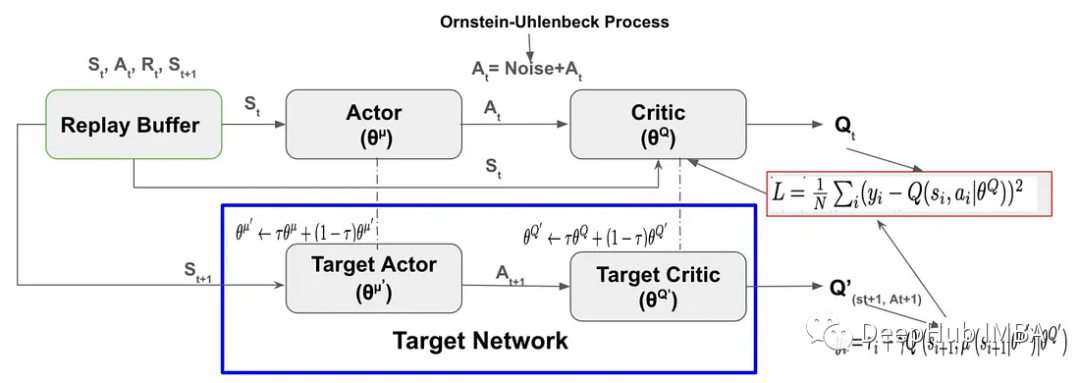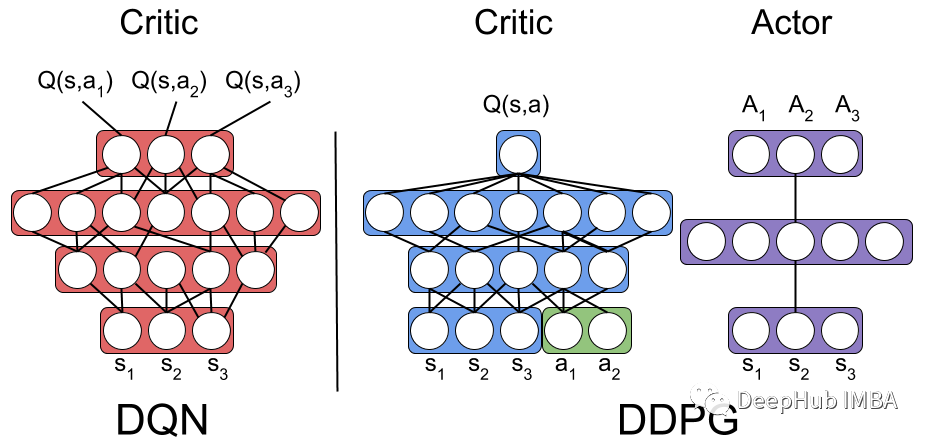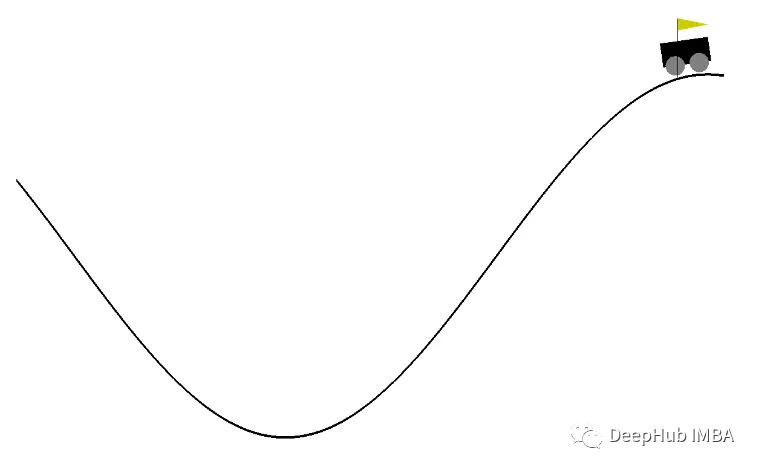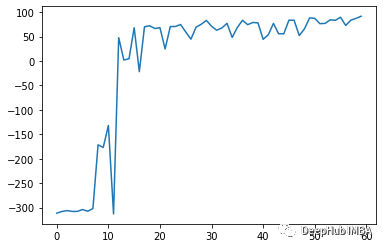深度确定性策略梯度(Deep Deterministic Policy Gradient, DDPG)是受Deep Q-Network启发的无模型、非策略深度强化算法,是基于使用策略梯度的Actor-Critic,本文将使用pytorch对其进行完整的实现和讲解

DDPG的关键组成部分是
- Replay Buffer
- Actor-Critic neural network
- Exploration Noise
- Target network
- Soft Target Updates for Target Network
下面我们一个一个来逐步实现:
Replay Buffer
DDPG使用Replay Buffer存储通过探索环境采样的过程和奖励(Sₜ,aₜ,Rₜ,Sₜ+₁)。Replay Buffer在帮助代理加速学习以及DDPG的稳定性方面起着至关重要的作用:
- 最小化样本之间的相关性:将过去的经验存储在 Replay Buffer 中,从而允许代理从各种经验中学习。
- 启用离线策略学习:允许代理从重播缓冲区采样转换,而不是从当前策略采样转换。
- 高效采样:将过去的经验存储在缓冲区中,允许代理多次从不同的经验中学习。
class Replay_buffer():
'''
Code based on:
https://github.com/openai/baselines/blob/master/baselines/deepq/replay_buffer.py
Expects tuples of (state, next_state, action, reward, done)
'''
def __init__(self, max_size=capacity):
"""Create Replay buffer.
Parameters
----------
size: int
Max number of transitions to store in the buffer. When the buffer
overflows the old memories are dropped.
"""
self.storage = []
self.max_size = max_size
self.ptr = 0
def push(self, data):
if len(self.storage) == self.max_size:
self.storage[int(self.ptr)] = data
self.ptr = (self.ptr + 1) % self.max_size
else:
self.storage.append(data)
def sample(self, batch_size):
"""Sample a batch of experiences.
Parameters
----------
batch_size: int
How many transitions to sample.
Returns
-------
state: np.array
batch of state or observations
action: np.array
batch of actions executed given a state
reward: np.array
rewards received as results of executing action
next_state: np.array
next state next state or observations seen after executing action
done: np.array
done[i] = 1 if executing ation[i] resulted in
the end of an episode and 0 otherwise.
"""
ind = np.random.randint(0, len(self.storage), size=batch_size)
state, next_state, action, reward, done = [], [], [], [], []
for i in ind:
st, n_st, act, rew, dn = self.storage[i]
state.append(np.array(st, copy=False))
next_state.append(np.array(n_st, copy=False))
action.append(np.array(act, copy=False))
reward.append(np.array(rew, copy=False))
done.append(np.array(dn, copy=False))
return np.array(state), np.array(next_state), np.array(action), np.array(reward).reshape(-1, 1), np.array(done).reshape(-1, 1)
Actor-Critic Neural Network
这是Actor-Critic 强化学习算法的 PyTorch 实现。该代码定义了两个神经网络模型,一个 Actor 和一个 Critic。
Actor 模型的输入:环境状态;Actor 模型的输出:具有连续值的动作。
Critic 模型的输入:环境状态和动作;Critic 模型的输出:Q 值,即当前状态-动作对的预期总奖励。
class Actor(nn.Module):
"""
The Actor model takes in a state observation as input and
outputs an action, which is a continuous value.
It consists of four fully connected linear layers with ReLU activation functions and
a final output layer selects one single optimized action for the state
"""
def __init__(self, n_states, action_dim, hidden1):
super(Actor, self).__init__()
self.net = nn.Sequential(
nn.Linear(n_states, hidden1),
nn.ReLU(),
nn.Linear(hidden1, hidden1),
nn.ReLU(),
nn.Linear(hidden1, hidden1),
nn.ReLU(),
nn.Linear(hidden1, 1)
)
def forward(self, state):
return self.net(state)
class Critic(nn.Module):
"""
The Critic model takes in both a state observation and an action as input and
outputs a Q-value, which estimates the expected total reward for the current state-action pair.
It consists of four linear layers with ReLU activation functions,
State and action inputs are concatenated before being fed into the first linear layer.
The output layer has a single output, representing the Q-value
"""
def __init__(self, n_states, action_dim, hidden2):
super(Critic, self).__init__()
self.net = nn.Sequential(
nn.Linear(n_states + action_dim, hidden2),
nn.ReLU(),
nn.Linear(hidden2, hidden2),
nn.ReLU(),
nn.Linear(hidden2, hidden2),
nn.ReLU(),
nn.Linear(hidden2, action_dim)
)
def forward(self, state, action):
return self.net(torch.cat((state, action), 1))
Exploration Noise
向 Actor 选择的动作添加噪声是 DDPG 中用来鼓励探索和改进学习过程的一种技术。
可以使用高斯噪声或 Ornstein-Uhlenbeck 噪声。 高斯噪声简单且易于实现,Ornstein-Uhlenbeck 噪声会生成时间相关的噪声,可以帮助代理更有效地探索动作空间。但是与高斯噪声方法相比,Ornstein-Uhlenbeck 噪声波动更平滑且随机性更低。
import numpy as np
import random
import copy
class OU_Noise(object):
"""Ornstein-Uhlenbeck process.
code from :
https://math.stackexchange.com/questions/1287634/implementing-ornstein-uhlenbeck-in-matlab
The OU_Noise class has four attributes
size: the size of the noise vector to be generated
mu: the mean of the noise, set to 0 by default
theta: the rate of mean reversion, controlling how quickly the noise returns to the mean
sigma: the volatility of the noise, controlling the magnitude of fluctuations
"""
def __init__(self, size, seed, mu=0., theta=0.15, sigma=0.2):
self.mu = mu * np.ones(size)
self.theta = theta
self.sigma = sigma
self.seed = random.seed(seed)
self.reset()
def reset(self):
"""Reset the internal state (= noise) to mean (mu)."""
self.state = copy.copy(self.mu)
def sample(self):
"""Update internal state and return it as a noise sample.
This method uses the current state of the noise and generates the next sample
"""
dx = self.theta * (self.mu - self.state) + self.sigma * np.array([np.random.normal() for _ in range(len(self.state))])
self.state += dx
return self.state
要在DDPG中使用高斯噪声,可以直接将高斯噪声添加到代理的动作选择过程中。
DDPG
DDPG (Deep Deterministic Policy Gradient)采用两组Actor-Critic神经网络进行函数逼近。在DDPG中,目标网络是Actor-Critic ,它目标网络具有与Actor-Critic网络相同的结构和参数化。
在训练期时,代理使用其 Actor-Critic 网络与环境交互,并将经验元组(Sₜ、Aₜ、Rₜ、Sₜ+₁)存储在Replay Buffer中。 然后代理从 Replay Buffer 中采样并使用数据更新 Actor-Critic 网络。 DDPG 算法不是通过直接从 Actor-Critic 网络复制来更新目标网络权重,而是通过称为软目标更新的过程缓慢更新目标网络权重。

软目标的更新是从Actor-Critic网络传输到目标网络的称为目标更新率(τ)的权重的一小部分。
软目标的更新公式如下:

通过使用软目标技术,可以大大提高学习的稳定性。
#Set Hyperparameters
# Hyperparameters adapted for performance from
capacity=1000000
batch_size=64
update_iteration=200
tau=0.001 # tau for soft updating
gamma=0.99 # discount factor
directory = './'
hidden1=20 # hidden layer for actor
hidden2=64. #hiiden laye for critic
class DDPG(object):
def __init__(self, state_dim, action_dim):
"""
Initializes the DDPG agent.
Takes three arguments:
state_dim which is the dimensionality of the state space,
action_dim which is the dimensionality of the action space, and
max_action which is the maximum value an action can take.
Creates a replay buffer, an actor-critic networks and their corresponding target networks.
It also initializes the optimizer for both actor and critic networks alog with
counters to track the number of training iterations.
"""
self.replay_buffer = Replay_buffer()
self.actor = Actor(state_dim, action_dim, hidden1).to(device)
self.actor_target = Actor(state_dim, action_dim, hidden1).to(device)
self.actor_target.load_state_dict(self.actor.state_dict())
self.actor_optimizer = optim.Adam(self.actor.parameters(), lr=3e-3)
self.critic = Critic(state_dim, action_dim, hidden2).to(device)
self.critic_target = Critic(state_dim, action_dim, hidden2).to(device)
self.critic_target.load_state_dict(self.critic.state_dict())
self.critic_optimizer = optim.Adam(self.critic.parameters(), lr=2e-2)
# learning rate
self.num_critic_update_iteration = 0
self.num_actor_update_iteration = 0
self.num_training = 0
def select_action(self, state):
"""
takes the current state as input and returns an action to take in that state.
It uses the actor network to map the state to an action.
"""
state = torch.FloatTensor(state.reshape(1, -1)).to(device)
return self.actor(state).cpu().data.numpy().flatten()
def update(self):
"""
updates the actor and critic networks using a batch of samples from the replay buffer.
For each sample in the batch, it computes the target Q value using the target critic network and the target actor network.
It then computes the current Q value
using the critic network and the action taken by the actor network.
It computes the critic loss as the mean squared error between the target Q value and the current Q value, and
updates the critic network using gradient descent.
It then computes the actor loss as the negative mean Q value using the critic network and the actor network, and
updates the actor network using gradient ascent.
Finally, it updates the target networks using
soft updates, where a small fraction of the actor and critic network weights are transferred to their target counterparts.
This process is repeated for a fixed number of iterations.
"""
for it in range(update_iteration):
# For each Sample in replay buffer batch
state, next_state, action, reward, done = self.replay_buffer.sample(batch_size)
state = torch.FloatTensor(state).to(device)
action = torch.FloatTensor(action).to(device)
next_state = torch.FloatTensor(next_state).to(device)
done = torch.FloatTensor(1-done).to(device)
reward = torch.FloatTensor(reward).to(device)
# Compute the target Q value
target_Q = self.critic_target(next_state, self.actor_target(next_state))
target_Q = reward + (done * gamma * target_Q).detach()
# Get current Q estimate
current_Q = self.critic(state, action)
# Compute critic loss
critic_loss = F.mse_loss(current_Q, target_Q)
# Optimize the critic
self.critic_optimizer.zero_grad()
critic_loss.backward()
self.critic_optimizer.step()
# Compute actor loss as the negative mean Q value using the critic network and the actor network
actor_loss = -self.critic(state, self.actor(state)).mean()
# Optimize the actor
self.actor_optimizer.zero_grad()
actor_loss.backward()
self.actor_optimizer.step()
"""
Update the frozen target models using
soft updates, where
tau,a small fraction of the actor and critic network weights are transferred to their target counterparts.
"""
for param, target_param in zip(self.critic.parameters(), self.critic_target.parameters()):
target_param.data.copy_(tau * param.data + (1 - tau) * target_param.data)
for param, target_param in zip(self.actor.parameters(), self.actor_target.parameters()):
target_param.data.copy_(tau * param.data + (1 - tau) * target_param.data)
self.num_actor_update_iteration += 1
self.num_critic_update_iteration += 1
def save(self):
"""
Saves the state dictionaries of the actor and critic networks to files
"""
torch.save(self.actor.state_dict(), directory + 'actor.pth')
torch.save(self.critic.state_dict(), directory + 'critic.pth')
def load(self):
"""
Loads the state dictionaries of the actor and critic networks to files
"""
self.actor.load_state_dict(torch.load(directory + 'actor.pth'))
self.critic.load_state_dict(torch.load(directory + 'critic.pth'))
训练DDPG
这里我们使用 OpenAI Gym 的“MountainCarContinuous-v0”来训练我们的DDPG RL 模型,这里的环境提供连续的行动和观察空间,目标是尽快让小车到达山顶。

下面定义算法的各种参数,例如最大训练次数、探索噪声和记录间隔等等。 使用固定的随机种子可以使得过程能够回溯。
import gym
# create the environment
env_name='MountainCarContinuous-v0'
env = gym.make(env_name)
device = 'cuda' if torch.cuda.is_available() else 'cpu'
# Define different parameters for training the agent
max_episode=100
max_time_steps=5000
ep_r = 0
total_step = 0
score_hist=[]
# for rensering the environmnet
render=True
render_interval=10
# for reproducibility
env.seed(0)
torch.manual_seed(0)
np.random.seed(0)
#Environment action ans states
state_dim = env.observation_space.shape[0]
action_dim = env.action_space.shape[0]
max_action = float(env.action_space.high[0])
min_Val = torch.tensor(1e-7).float().to(device)
# Exploration Noise
exploration_noise=0.1
exploration_noise=0.1 * max_action
创建DDPG代理类的实例,以训练代理达到指定的次数。在每轮结束时调用代理的update()方法来更新参数,并且在每十轮之后使用save()方法将代理的参数保存到一个文件中。
# Create a DDPG instance
agent = DDPG(state_dim, action_dim)
# Train the agent for max_episodes
for i in range(max_episode):
total_reward = 0
step =0
state = env.reset()
for t in range(max_time_steps):
action = agent.select_action(state)
# Add Gaussian noise to actions for exploration
action = (action + np.random.normal(0, 1, size=action_dim)).clip(-max_action, max_action)
#action += ou_noise.sample()
next_state, reward, done, info = env.step(action)
total_reward += reward
if render and i >= render_interval : env.render()
agent.replay_buffer.push((state, next_state, action, reward, np.float(done)))
state = next_state
if done:
break
step += 1
score_hist.append(total_reward)
total_step += step+1
print("Episode: \t{} Total Reward: \t{:0.2f}".format( i, total_reward))
agent.update()
if i % 10 == 0:
agent.save()
env.close()
测试DDPG
test_iteration=100
for i in range(test_iteration):
state = env.reset()
for t in count():
action = agent.select_action(state)
next_state, reward, done, info = env.step(np.float32(action))
ep_r += reward
print(reward)
env.render()
if done:
print("reward{}".format(reward))
print("Episode \t{}, the episode reward is \t{:0.2f}".format(i, ep_r))
ep_r = 0
env.render()
break
state = next_state
我们使用下面的参数让模型收敛:
- 从标准正态分布中采样噪声,而不是随机采样。
- 将polyak常数(tau)从0.99更改为0.001
- 修改Critic 网络的隐藏层大小为[64,64]。在Critic 网络的第二层之后删除了ReLU激活。改成(Linear, ReLU, Linear, Linear)。
- 最大缓冲区大小更改为1000000
- 将batch_size的大小从128更改为64
训练了75轮之后的效果如下:

总结
DDPG算法是一种受deep Q-Network (DQN)算法启发的无模型off-policy Actor-Critic算法。它结合了策略梯度方法和Q-learning的优点来学习连续动作空间的确定性策略。
与DQN类似,它使用重播缓冲区存储过去的经验和目标网络,用于训练网络,从而提高了训练过程的稳定性。
DDPG算法需要仔细的超参数调优以获得最佳性能。超参数包括学习率、批大小、目标网络更新速率和探测噪声参数。超参数的微小变化会对算法的性能产生重大影响。










































